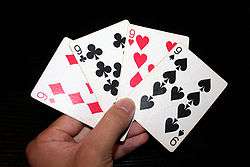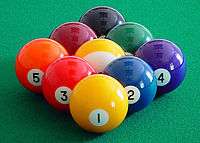9
9 (nine) is the natural number following 8 and preceding 10.
| ||||
|---|---|---|---|---|
[[{{#expr: (floor({{{number}}} div {{{factor}}})) * {{{factor}}}+({{{1}}}*{{{factor}}} div 10)}} (number)|{{#switch:{{{1}}}|-1={{#ifexpr:(floor({{{number}}} div 10)) = 0|-1|←}}|10=→|#default={{#expr:(floor({{{number}}} div {{{factor}}})) * {{{factor}}}+({{{1}}}*{{{factor}}} div 10)}}}}]] [[{{#expr: (floor({{{number}}} div {{{factor}}})) * {{{factor}}}+({{{1}}}*{{{factor}}} div 10)}} (number)|{{#switch:{{{1}}}|-1={{#ifexpr:(floor({{{number}}} div 10)) = 0|-1|←}}|10=→|#default={{#expr:(floor({{{number}}} div {{{factor}}})) * {{{factor}}}+({{{1}}}*{{{factor}}} div 10)}}}}]] [[{{#expr: (floor({{{number}}} div {{{factor}}})) * {{{factor}}}+({{{1}}}*{{{factor}}} div 10)}} (number)|{{#switch:{{{1}}}|-1={{#ifexpr:(floor({{{number}}} div 10)) = 0|-1|←}}|10=→|#default={{#expr:(floor({{{number}}} div {{{factor}}})) * {{{factor}}}+({{{1}}}*{{{factor}}} div 10)}}}}]] [[{{#expr: (floor({{{number}}} div {{{factor}}})) * {{{factor}}}+({{{1}}}*{{{factor}}} div 10)}} (number)|{{#switch:{{{1}}}|-1={{#ifexpr:(floor({{{number}}} div 10)) = 0|-1|←}}|10=→|#default={{#expr:(floor({{{number}}} div {{{factor}}})) * {{{factor}}}+({{{1}}}*{{{factor}}} div 10)}}}}]] [[{{#expr: (floor({{{number}}} div {{{factor}}})) * {{{factor}}}+({{{1}}}*{{{factor}}} div 10)}} (number)|{{#switch:{{{1}}}|-1={{#ifexpr:(floor({{{number}}} div 10)) = 0|-1|←}}|10=→|#default={{#expr:(floor({{{number}}} div {{{factor}}})) * {{{factor}}}+({{{1}}}*{{{factor}}} div 10)}}}}]] [[{{#expr: (floor({{{number}}} div {{{factor}}})) * {{{factor}}}+({{{1}}}*{{{factor}}} div 10)}} (number)|{{#switch:{{{1}}}|-1={{#ifexpr:(floor({{{number}}} div 10)) = 0|-1|←}}|10=→|#default={{#expr:(floor({{{number}}} div {{{factor}}})) * {{{factor}}}+({{{1}}}*{{{factor}}} div 10)}}}}]] [[{{#expr: (floor({{{number}}} div {{{factor}}})) * {{{factor}}}+({{{1}}}*{{{factor}}} div 10)}} (number)|{{#switch:{{{1}}}|-1={{#ifexpr:(floor({{{number}}} div 10)) = 0|-1|←}}|10=→|#default={{#expr:(floor({{{number}}} div {{{factor}}})) * {{{factor}}}+({{{1}}}*{{{factor}}} div 10)}}}}]] [[{{#expr: (floor({{{number}}} div {{{factor}}})) * {{{factor}}}+({{{1}}}*{{{factor}}} div 10)}} (number)|{{#switch:{{{1}}}|-1={{#ifexpr:(floor({{{number}}} div 10)) = 0|-1|←}}|10=→|#default={{#expr:(floor({{{number}}} div {{{factor}}})) * {{{factor}}}+({{{1}}}*{{{factor}}} div 10)}}}}]] [[{{#expr: (floor({{{number}}} div {{{factor}}})) * {{{factor}}}+({{{1}}}*{{{factor}}} div 10)}} (number)|{{#switch:{{{1}}}|-1={{#ifexpr:(floor({{{number}}} div 10)) = 0|-1|←}}|10=→|#default={{#expr:(floor({{{number}}} div {{{factor}}})) * {{{factor}}}+({{{1}}}*{{{factor}}} div 10)}}}}]] [[{{#expr: (floor({{{number}}} div {{{factor}}})) * {{{factor}}}+({{{1}}}*{{{factor}}} div 10)}} (number)|{{#switch:{{{1}}}|-1={{#ifexpr:(floor({{{number}}} div 10)) = 0|-1|←}}|10=→|#default={{#expr:(floor({{{number}}} div {{{factor}}})) * {{{factor}}}+({{{1}}}*{{{factor}}} div 10)}}}}]] [[{{#expr: (floor({{{number}}} div {{{factor}}})) * {{{factor}}}+({{{1}}}*{{{factor}}} div 10)}} (number)|{{#switch:{{{1}}}|-1={{#ifexpr:(floor({{{number}}} div 10)) = 0|-1|←}}|10=→|#default={{#expr:(floor({{{number}}} div {{{factor}}})) * {{{factor}}}+({{{1}}}*{{{factor}}} div 10)}}}}]] [[{{#expr: (floor({{{number}}} div {{{factor}}})) * {{{factor}}}+({{{1}}}*{{{factor}}} div 10)}} (number)|{{#switch:{{{1}}}|-1={{#ifexpr:(floor({{{number}}} div 10)) = 0|-1|←}}|10=→|#default={{#expr:(floor({{{number}}} div {{{factor}}})) * {{{factor}}}+({{{1}}}*{{{factor}}} div 10)}}}}]] | ||||
| Cardinal | nine | |||
| Ordinal | 9th (ninth) | |||
| Numeral system | nonary | |||
| Factorization | 32 | |||
| Divisors | 1, 3, 9 | |||
| Greek numeral | Θ´ | |||
| Roman numeral | IX, ix | |||
| Greek prefix | ennea- | |||
| Latin prefix | nona- | |||
| Binary | 10012 | |||
| Ternary | 1003 | |||
| Quaternary | 214 | |||
| Quinary | 145 | |||
| Senary | 136 | |||
| Octal | 118 | |||
| Duodecimal | 912 | |||
| Hexadecimal | 916 | |||
| Vigesimal | 920 | |||
| Base 36 | 936 | |||
| Amharic | ፱ | |||
| Arabic, Kurdish, Persian, Sindhi, Urdu | ٩ | |||
| Armenian numeral | Թ | |||
| Bengali | ৯ | |||
| Chinese numeral | 九, 玖 | |||
| Devanāgarī | ९ | |||
| Greek numeral | θ´ | |||
| Hebrew numeral | ט | |||
| Tamil numerals | ௯ | |||
| Khmer | ៩ | |||
| Telugu numeral | ౯ | |||
| Thai numeral | ๙ | |||
| Look up nine in Wiktionary, the free dictionary. |
Mathematics
9 is a composite number, its proper divisors being 1 and 3. It is 3 times 3 and hence the third square number. Nine is a Motzkin number.[1] It is the first composite lucky number, along with the first composite odd number and only single-digit composite odd number.
9 is the only positive perfect power that is one more than another positive perfect power, by Mihăilescu's Theorem.
9 is the highest single-digit number in the decimal system. It is the second non-unitary square prime of the form (p2) and the first that is odd. All subsequent squares of this form are odd.
Since 9 = 321, 9 is an exponential factorial.[2]
A polygon with nine sides is called a nonagon or enneagon.[3] A group of nine of anything is called an ennead.
In base 10, a positive number is divisible by 9 if and only if its digital root is 9.[4] That is, if any natural number is multiplied by 9, and the digits of the answer are repeatedly added until it is just one digit, the sum will be nine:
- 2 × 9 = 18 (1 + 8 = 9)
- 3 × 9 = 27 (2 + 7 = 9)
- 9 × 9 = 81 (8 + 1 = 9)
- 121 × 9 = 1089 (1 + 0 + 8 + 9 = 18; 1 + 8 = 9)
- 234 × 9 = 2106 (2 + 1 + 0 + 6 = 9)
- 578329 × 9 = 5204961 (5 + 2 + 0 + 4 + 9 + 6 + 1 = 27; 2 + 7 = 9)
- 482729235601 × 9 = 4344563120409 (4 + 3 + 4 + 4 + 5 + 6 + 3 + 1 + 2 + 0 + 4 + 0 + 9 = 45; 4 + 5 = 9)
There are other interesting patterns involving multiples of nine:
- 12345679 × 9 = 111111111
- 12345679 × 18 = 222222222
- 12345679 × 81 = 999999999
This works for all the multiples of 9. n = 3 is the only other n > 1 such that a number is divisible by n if and only if its digital root is divisible by n. In base-N, the divisors of N − 1 have this property. Another consequence of 9 being 10 − 1, is that it is also a Kaprekar number.
The difference between a base-10 positive integer and the sum of its digits is a whole multiple of nine. Examples:
- The sum of the digits of 41 is 5, and 41 − 5 = 36. The digital root of 36 is 3 + 6 = 9, which, as explained above, demonstrates that it is divisible by nine.
- The sum of the digits of 35967930 is 3 + 5 + 9 + 6 + 7 + 9 + 3 + 0 = 42, and 35967930 − 42 = 35967888. The digital root of 35967888 is 3 + 5 + 9 + 6 + 7 + 8 + 8 + 8 = 54, 5 + 4 = 9.
Casting out nines is a quick way of testing the calculations of sums, differences, products, and quotients of integers, known as long ago as the 12th century.[5]
Six recurring nines appear in the decimal places 762 through 767 of π, see Six nines in pi.
If dividing a number by the amount of 9s corresponding to its number of digits, the number is turned into a repeating decimal. (e.g. 274/999 = 0.274274274274...)
There are nine Heegner numbers.[6]
Probability
In probability, the nine is a logarithmic measure of the probability of an event, defined as the negative of the base-10 logarithm of the probability of the event's complement. For example, an event that is 99% likely to occur has an unlikelihood of 1% or 0.01, which amounts to −log10 0.01 = 2 nines of probability. Zero probability gives zero nines (−log10 1 = 0). A 100% probability is considered to be impossible in most circumstances: that results in infinite improbability. The effectivity of processes and the availability of systems can be expressed (as a rule of thumb, not explicitly) as a series of "nines". For example, "five nines" (99.999%) availability implies a total downtime of no more than five minutes per year – typically a very high degree of reliability; but never 100%.
List of basic calculations
| Multiplication | 1 | 2 | 3 | 4 | 5 | 6 | 7 | 8 | 9 | 10 | 20 | 25 | 50 | 100 | 1000 |
|---|---|---|---|---|---|---|---|---|---|---|---|---|---|---|---|
| 9 × x | 9 | 18 | 27 | 36 | 45 | 54 | 63 | 72 | 81 | 90 | 180 | 225 | 450 | 900 | 9000 |
| Division | 1 | 2 | 3 | 4 | 5 | 6 | 7 | 8 | 9 | 10 | 11 | 12 | 13 | 14 | 15 |
|---|---|---|---|---|---|---|---|---|---|---|---|---|---|---|---|
| 9 ÷ x | 9 | 4.5 | 3 | 2.25 | 1.8 | 1.5 | 1.285714 | 1.125 | 1 | 0.9 | 0.81 | 0.75 | 0.692307 | 0.6428571 | 0.6 |
| 'x ÷ 9 | 0.1 | 0.2 | 0.3 | 0.4 | 0.5 | 0.6 | 0.7 | 0.8 | 1 | 1.1 | 1.2 | 1.3 | 1.4 | 1.5 | 1.6 |
| Exponentiation | 1 | 2 | 3 | 4 | 5 | 6 | 7 | 8 | 9 | 10 |
|---|---|---|---|---|---|---|---|---|---|---|
| 9x | 9 | 81 | 729 | 6561 | 59049 | 531441 | 4782969 | 43046721 | 387420489 | 3486784401 |
| x9 | 1 | 512 | 19683 | 262144 | 1953125 | 10077696 | 40353607 | 134217728 | 387420489 | 1000000000 |
| Radix | 1 | 5 | 10 | 15 | 20 | 25 | 30 | 40 | 50 | 60 | 70 | 80 | 90 | 100 |
|---|---|---|---|---|---|---|---|---|---|---|---|---|---|---|
| 110 | 120 | 130 | 140 | 150 | 200 | 250 | 500 | 1000 | 10000 | 100000 | 1000000 | |||
| x9 | 1 | 5 | 119 | 169 | 229 | 279 | 339 | 449 | 559 | 669 | 779 | 889 | 1109 | 1219 |
| 1329 | 1439 | 1549 | 1659 | 1769 | 2429 | 3079 | 6159 | 13319 | 146419 | 1621519 | 17836619 |
Evolution of the glyph
According to Georges Ifrah, the origin of the 9 integers can be attributed to ancient Indian civilization, and was adopted by subsequent civilizations in conjunction with the 0.[7]

In the beginning, various Indians wrote 9 similar to the modern closing question mark without the bottom dot. The Kshatrapa, Andhra and Gupta started curving the bottom vertical line coming up with a 3-look-alike. The Nagari continued the bottom stroke to make a circle and enclose the 3-look-alike, in much the same way that the @ character encircles a lowercase a. As time went on, the enclosing circle became bigger and its line continued beyond the circle downwards, as the 3-look-alike became smaller. Soon, all that was left of the 3-look-alike was a squiggle. The Arabs simply connected that squiggle to the downward stroke at the middle and subsequent European change was purely cosmetic.
While the shape of the 9 character has an ascender in most modern typefaces, in typefaces with text figures the character usually has a descender, as, for example, in ![]()
This numeral resembles an inverted 6. To disambiguate the two on objects and documents that can be inverted, the 9 is often underlined, as is done for the 6. Another distinction from the 6 is that it is sometimes handwritten with a straight stem, resembling a raised lower-case letter q.
Alphabets and codes
- In the NATO phonetic alphabet, the digit 9 is called "Niner".
- Five-digit produce PLU codes that begin with 9 are organic.
Commerce
- Common terminal digit in psychological pricing.
Culture and mythology
Indian culture
Nine is a number that appears often in Indian culture and mythology. Some instances are enumerated below.
- Nine influencers are attested in Indian astrology.
- In the Vaisheshika branch of Hindu philosophy, there are nine universal substances or elements: Earth, Water, Air, Fire, Ether, Time, Space, Soul, and Mind.
- Navaratri is a nine-day festival dedicated to the nine forms of Durga.
- Navaratna, meaning "nine jewels" may also refer to Navaratnas – accomplished courtiers, Navratan – a kind of dish, or a form of architecture.
- In Indian aesthetics, there are nine kinds of Rasa.
Chinese culture
- Nine (九 pinyin jiǔ) is considered a good number in Chinese culture because it sounds the same as the word "long-lasting" (久 pinyin jiǔ).
- Nine is strongly associated with the Chinese dragon, a symbol of magic and power. There are nine forms of the dragon, it is described in terms of nine attributes, and it has nine children. It has 117 scales – 81 yang (masculine, heavenly) and 36 yin (feminine, earthly). All three numbers are multiples of 9 (9 × 13 = 117, 9 × 9 = 81, 9 × 4 = 36)[8] as well as having the same digital root of 9.
- The dragon often symbolizes the Emperor, and the number nine can be found in many ornaments in the Forbidden City.
- The circular altar platform (Earthly Mount) of the Temple of Heaven has one circular marble plate in the center, surrounded by a ring of nine plates, then by a ring of 18 plates, and so on, for a total of nine rings, with the outermost having 81 = 9 × 9 plates.
- The name of the area called Kowloon in Hong Kong literally means: nine dragons.
- The nine-dotted line (Chinese: 南海九段线; pinyin: nánhǎi jiǔduàn xiàn; lit.: 'Nine-segment line of the South China Sea') delimits certain island claims by China in the South China Sea.
- The nine-rank system was a civil service nomination system used during certain Chinese dynasties.
- 9 Points of the Heart (Heal) / Heart Master (Immortality) Channels in Traditional Chinese Medicine.
Ancient Egypt
- The nine bows is a term used in Ancient Egypt to represent the traditional enemies of Egypt.
- The Ennead is a group of nine Egyptian deities, who, in some versions of the Osiris myth, judged whether Horus or Set should inherit Egypt.
European culture
- The Nine Worthies are nine historical, or semi-legendary figures who, in the Middle Ages, were believed to personify the ideals of chivalry.
- In Norse mythology, the universe is divided into nine worlds which are all connected by the world tree Yggdrasil
- In Norse mythology as well, the number nine is associated with Odin, as that is how many days he hung from the world tree Yggdrasil before attaining knowledge of the runes.
Greek mythology
- The nine Muses in Greek mythology are Calliope (epic poetry), Clio (history), Erato (erotic poetry), Euterpe (lyric poetry), Melpomene (tragedy), Polyhymnia (song), Terpsichore (dance), Thalia (comedy), and Urania (astronomy).
- It takes nine days (for an anvil) to fall from heaven to earth, and nine more to fall from earth to Tartarus.
- Leto labored for nine days and nine nights for Apollo, according to the Homeric Hymn to Delian Apollo.
Mesoamerican mythology
- The Lords of the Night, is a group of nine deities who each ruled over every ninth night forming a calendrical cycle
Aztec mythology
- Mictlan the underworld in Aztec mythology, consists of nine levels.
Mayan mythology
- The Mayan underworld Xibalba consists of nine levels.
- El Castillo the Mayan step-pyramid in Chichén Itzá, consists of nine steps. It is said that this was done to represent the nine levels of Xibalba.
Anthropology
Idioms
- "to go the whole nine yards-"
- "A cat-o'-nine-tails suggests perfect punishment and atonement." – Robert Ripley.
- "A cat has nine lives"
- "to be on cloud nine"
- "A stitch in time saves nine"
- "found true 9 out of 10 times"
- "possession is nine tenths of the law"
- The word "K-9" pronounces the same as canine and is used in many US police departments to denote the police dog unit. Despite not sounding like the translation of the word canine in other languages, many police and military units around the world use the same designation.
- Someone dressed "to the nines" is dressed up as much as they can be.
- In North American urban culture, "nine" is a slang word for a 9mm pistol or homicide, the latter from the Illinois Criminal Code for homicide.
Society
- The 9 on Yahoo!, hosted by Maria Sansone, was a daily video compilation show, or vlog, on Yahoo! featuring the nine top "web finds" of the day.
- Nine justices sit on the United States Supreme Court.
Technique


- Stanines, a method of scaling test scores, range from 1 to 9.
- There are 9 square feet in a square yard.
Literature
- There are nine circles of Hell in Dante's Divine Comedy.
- The Nine Bright Shiners, characters in Garth Nix's Old Kingdom trilogy. The Nine Bright Shiners was a 1930s book of poems by Anne Ridler[9] and a 1988 fiction book by Anthea Fraser;[10] the name derives from "a very curious old semi-pagan, semi-Christian" song.[11]
- The Nine Tailors is a 1934 mystery novel by British writer Dorothy L. Sayers, her ninth featuring sleuth Lord Peter Wimsey.
- Nine Unknown Men are, in occult legend, the custodians of the sciences of the world since ancient times.
- In J. R. R. Tolkien's Middle-earth, there are nine rings of power given to men, and consequently, nine ringwraiths. Additionally, The Fellowship of the Ring consists of nine companions.
- In Lorien Legacies there are nine Garde sent to Earth.
- Number Nine is a character in Lorien Legacies.
- In the series A Song of Ice and Fire, there are nine regions of Westeros (the Crownlands, the North, the Riverlands, the Westerlands, the Reach, the Stormlands, the Vale of Arryn, the Iron Islands and Dorne). Additionally, there is a group of nine city-states in western Essos known collectively as the Free Cities (Braavos, Lorath, Lys, Myr, Norvos, Pentos, Qohor, Tyrosh and Volantis).
Organizations
- Divine Nine – The National Pan-Hellenic Council (NPHC) is a collaborative organization of nine historically African American, international Greek-lettered fraternities and sororities.
Places and thoroughfares
- List of highways numbered 9
- Ninth Avenue is a major avenue in Manhattan.
- South Africa has 9 provinces
Religion and philosophy

- Nine, as the highest single-digit number (in base ten), symbolizes completeness in the Bahá'í Faith. In addition, the word Bahá' in the Abjad notation has a value of 9, and a 9-pointed star is used to symbolize the religion.
- The number 9 is revered in Hinduism and considered a complete, perfected and divine number because it represents the end of a cycle in the decimal system, which originated from the Indian subcontinent as early as 3000 BC.
- In Buddhism, Gautama Buddha was believed to have nine virtues, which he was (1) Accomplished, (2) Perfectly Enlightened, (3) Endowed with knowledge and Conduct or Practice, (4) Well-gone or Well-spoken, (5) the Knower of worlds, (6) the Guide Unsurpassed of men to be tamed, (7) the Teacher of gods and men, (8) Enlightened, and (9) Blessed.
- Important Buddhist rituals usually involve nine monks.
- The first nine days of the Hebrew month of Av are collectively known as "The Nine Days" (Tisha HaYamim), and are a period of semi-mourning leading up to Tisha B'Av, the ninth day of Av on which both Temples in Jerusalem were destroyed.
- Nine is a significant number in Norse Mythology. Odin hung himself on an ash tree for nine days to learn the runes.
- The Fourth Way Enneagram is one system of knowledge which shows the correspondence between the 9 integers and the circle.
- In the Christian angelic hierarchy there are 9 choirs of angels.
- Ramadan, the month of fasting and prayer, is the ninth month of the Islamic calendar.
- Tian's Trigram Number, of Feng Shui, in Taoism.
- In Christianity there are nine Fruit of the Holy Spirit which followers are expected to have: love, joy, peace, patience, kindness, goodness, faithfulness, gentleness, and self-control.
Science
Astronomy
- Before 2006 (when Pluto was officially designated as a non-planet), there were nine planets in the solar system.
- Messier object M9 is a magnitude 9.0 globular cluster in the constellation Ophiuchus.
- The New General Catalogue object NGC 9, a spiral galaxy in the constellation Pegasus.
Chemistry
- The purity of chemicals (see Nine (purity)).
- Nine is the atomic number of fluorine.
Physiology
A human pregnancy normally lasts nine months, the basis of Naegele's rule.
Sports
- Nine-ball is the standard professional pocket billiards variant played in the United States.
- In association football (soccer), the centre-forward/striker traditionally (since at least the fifties) wears the number 9 shirt.
- In baseball:
- There are nine players on the field including the pitcher.
- There are nine innings in a standard game.
- 9 represents the right fielder's position.
- NINE: A Journal of Baseball History and Culture, published by the University of Nebraska Press[12]
- In rugby league, the jersey number assigned to the hooker in most competitions. (An exception is the Super League, which uses static squad numbering.)
- In rugby union, the number worn by the starting scrum-half.
Technology
- ISO 9 is the ISO's standard for the transliteration of Cyrillic characters into Latin characters
- In the Rich Text Format specification, 9 is the language code for the English language. All codes for regional variants of English are congruent to 9 mod 256.
- The seven-segment display allows the number 9 to be constructed two ways, either with a hook at the end of its stem or without one. Most LCD calculators use the former, but some VFD models use the latter.
- The9 Limited (owner of the9.com) is a company in the video-game industry, including former ties to the extremely popular MMORPG World of Warcraft.
Music
- "Revolution 9", a sound collage which appears on The Beatles' eponymous 1968 album The Beatles (aka The White Album), prominently features a loop of a man's voice repeating the phrase "Number nine".
- There are 9 semitones in a Major 6th interval in music.
- There was a superstition among some notable classical music composers that they would die after completing their ninth symphony. Some composers who died after composing their ninth symphony include Ludwig van Beethoven, Anton Bruckner, Antonin Dvorak and Gustav Mahler.
See also
References
- "Sloane's A001006 : Motzkin numbers". The On-Line Encyclopedia of Integer Sequences. OEIS Foundation. Retrieved 2016-06-01.
- "Sloane's A049384 : a(0)=1, a(n+1) = (n+1)^a(n)". The On-Line Encyclopedia of Integer Sequences. OEIS Foundation. Retrieved 2016-06-01.
- Robert Dixon, Mathographics. New York: Courier Dover Publications: 24
- Martin Gardner, A Gardner's Workout: Training the Mind and Entertaining the Spirit. New York: A. K. Peters (2001): 155
- Cajori, Florian (1991, 5e) A History of Mathematics, AMS. ISBN 0-8218-2102-4. p.91
- Bryan Bunch, The Kingdom of Infinite Number. New York: W. H. Freeman & Company (2000): 93
- Georges Ifrah (1985). From One to Zero: A Universal History of Numbers. Viking. ISBN 0-670-37395-8.
- Donald Alexander Mackenzie (2005). Myths of China And Japan. Kessinger. ISBN 1-4179-6429-4.
- Jane Dowson (1996). Women's Poetry of the 1930s: A Critical Anthology. Routledge. ISBN 0-415-13095-6.
- Anthea Fraser (1988). The Nine Bright Shiners. Doubleday. ISBN 0-385-24323-5.
- Charles Herbert Malden (1905). Recollections of an Eton Colleger, 1898-1902. Spottiswoode. p. 182.
nine-bright-shiners.
- "Web site for NINE: A Journal of Baseball History & Culture". Archived from the original on 2009-11-04. Retrieved 20 February 2013.
Further reading
- Cecil Balmond, "Number 9, the search for the sigma code" 1998, Prestel 2008, ISBN 3-7913-1933-7, ISBN 978-3-7913-1933-9
